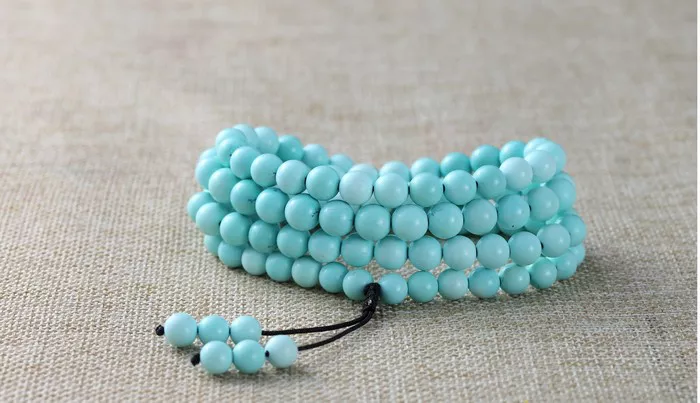Turquoise has captivated humanity for millennia, prized for its unique color and beauty. Among the various types of turquoise, Santa Rita turquoise stands out due to its distinctive characteristics and rich history. This article delves into the meaning and symbolism of Santa Rita turquoise, offering insights into its geological formation, cultural significance, and uses in contemporary settings.
Geological Formation and Characteristics of Santa Rita Turquoise
Santa Rita turquoise is a rare and highly sought-after variety of turquoise found in the southwestern United States, primarily in Arizona and New Mexico. The stone is named after the Santa Rita Mountains, a range that has been a significant source of turquoise for centuries. This variety of turquoise is known for its vibrant blue to blue-green hues, often with striking matrix patterns of black, brown, or gold, which add to its visual appeal.
Formation Process
Turquoise forms in arid regions where groundwater percolates through aluminous rock in the presence of copper. Over millions of years, this process results in the deposition of hydrated copper aluminum phosphate, creating the stunning blue-green mineral we know as turquoise. The presence of other elements, such as iron, can influence the color and matrix patterns, making each piece of Santa Rita turquoise unique.
Historical Significance and Cultural Importance
Santa Rita turquoise has a rich history that dates back thousands of years. Native American tribes, particularly the Navajo, Hopi, and Zuni, have revered this stone for its beauty and spiritual significance. Turquoise was used in ceremonial rituals, as well as in crafting jewelry and amulets.
Native American Beliefs
For many Native American cultures, turquoise is considered a sacred stone. It is believed to possess protective and healing properties, serving as a bridge between the physical and spiritual worlds. Turquoise amulets were often worn by warriors to ensure safety in battle, and the stone was used in various rituals to promote health and well-being.
Symbolism in Other Cultures
Beyond Native American traditions, turquoise has held symbolic meaning in many cultures throughout history. In ancient Egypt, turquoise was associated with protection and was often used in the creation of amulets and burial goods. The Chinese valued turquoise for its supposed ability to bring good fortune and ward off negative energy. In Persian culture, turquoise was seen as a symbol of paradise and was used extensively in art and architecture.
Modern Uses and Symbolism
Today, Santa Rita turquoise continues to be a popular choice for jewelry and decorative items. Its striking color and unique patterns make it a favorite among gem enthusiasts and jewelry designers. Beyond its aesthetic appeal, Santa Rita turquoise is also appreciated for its metaphysical properties.
Healing and Spiritual Properties
Many people believe that turquoise has a range of healing properties. It is thought to promote emotional balance, alleviate stress, and enhance communication. Wearing turquoise is said to help align the chakras, particularly the throat chakra, which is associated with communication and self-expression. Some also believe that turquoise can aid in detoxification and improve overall well-being.
Symbolism in Modern Contexts
In contemporary times, Santa Rita turquoise symbolizes wisdom, protection, and good fortune. It is often given as a gift to promote positive energy and to protect the wearer from harm. The stone’s vibrant color is associated with the sky and water, elements that are universally linked to life and renewal.
Santa Rita Turquoise in Jewelry Design
The unique beauty of Santa Rita turquoise makes it a favorite among jewelry designers. Its vibrant color and striking matrix patterns can be used to create a variety of stunning pieces, from simple pendants to intricate inlay work.
Designing with Santa Rita Turquoise
When designing with Santa Rita turquoise, jewelers often highlight the stone’s natural beauty by setting it in simple, elegant settings. Sterling silver is a popular choice for turquoise jewelry, as the cool tone of the metal complements the blue hues of the stone. However, turquoise can also be paired with gold or other metals for a more luxurious look.
Care and Maintenance
Like all turquoise, Santa Rita turquoise requires special care to maintain its beauty. The stone is relatively soft and can be easily scratched or damaged by chemicals. It is important to clean turquoise jewelry gently with a soft cloth and avoid exposure to harsh chemicals, extreme temperatures, and prolonged sunlight.
See Also: What Are The Benefits Of Green Copper Turquoise Gemstone?
Collecting Santa Rita Turquoise
For gem enthusiasts and collectors, Santa Rita turquoise represents a valuable addition to any collection. Its rarity and unique characteristics make it a sought-after stone among collectors.
Evaluating Quality
When evaluating Santa Rita turquoise, several factors should be considered, including color, matrix pattern, and overall condition. High-quality turquoise typically has a vibrant, even color with minimal matrix. However, some collectors prefer stones with interesting matrix patterns, as these can add to the stone’s uniqueness and beauty.
Authentication and Value
Due to the popularity of turquoise, it is important to ensure that the stone is authentic. Reputable dealers will provide information about the stone’s origin and any treatments it may have undergone. Natural, untreated turquoise is generally more valuable than treated or stabilized stones.
Conclusion
Santa Rita turquoise is a stone that embodies both beauty and rich cultural heritage. Its vibrant color and unique patterns make it a favorite among jewelers and collectors, while its historical and spiritual significance adds depth to its appeal. Whether worn as jewelry or displayed as a collector’s item, Santa Rita turquoise continues to captivate and inspire those who appreciate its unique qualities.
In summary, Santa Rita turquoise is more than just a beautiful stone; it is a symbol of protection, healing, and good fortune. Its rich history and cultural significance make it a treasured gem that continues to be valued in modern times. As you explore the world of turquoise, Santa Rita turquoise stands out as a particularly special and meaningful variety.


